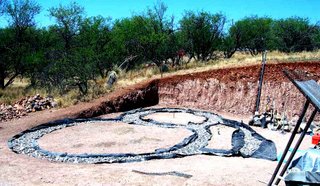
The "floating footing" or "rubble-trench footing" is an alternate approach to a building's base foundation for heavy clay soils, as opposed to simply pouring concrete into a footing trench. Clay soils are expansive and when wet could possibly put a lateral stress, or cause heaving to, a standard poured concrete footing.
In the concept of the 'floating footing', the typical 'in-ground' concrete footing is replaced by 1"-3" (rounded) river rock. The footing channel for my building, is 18"-deep and 2-foot wide. The footing was hand dug and a surveyor's level was used to ensure a slight pitch for drainage of the footing, leading to a pipe at the southeast corner of the building. The channel was lined with heavy-duty plastic to facilitate water drainage and keep the ground directly under the floating footing from getting saturated during heavy rains.
The river rock was compacted with a tamper and eventually brought up to grade level. On top of the floating footing will be a massive 2-foot wide 'stem-wall', made of large stone masonry. In most places this wall will be 2-foot wide.
I have been curious to employ this method ever since I heard Frank Lloyd Wright used a floating-footing for construction of the Imperial Hotel in Japan in 1916. This building subsequently survived a severe earthquake without major damage. The theory is that since the building rests on the surface (on top of the rubble filled trench), when an eathquake stikes, the rubble-trench slides under the building when subject to the lateral force of the earthquake.
The foundation of a building is critical to maintaining the integrity of the structure. It needs to be strong and the appropriate size for the building so the structure won't settle, buckle, or spread apart. Please note that the "floating footing" system is somewhat experimental and not appropriate for sandy soils or sloping terrain that can be eroded to the point where the rubble-filled trench would be exposed and compromised. Consult an soils/structural engineer if necessary for your project.

2 comments:
Hi,
Very beautiful rock work in yur building. it seems to me that you are trying to build a structure that will last for a thousand years or more!!! What's your motivation? Just curious. I hope to come by and see your work later this winter. Hopng to see your progress later on--Larry from Albuquerque.
Hi Larry:
Yes, the stem wall is quite solid - a 1,000 years would be nice. My motivation is to build structures suitable to the desert environment; using local resources (clay, sand, straw, bamboo); and solar power for personal energy independence....Bart
Post a Comment